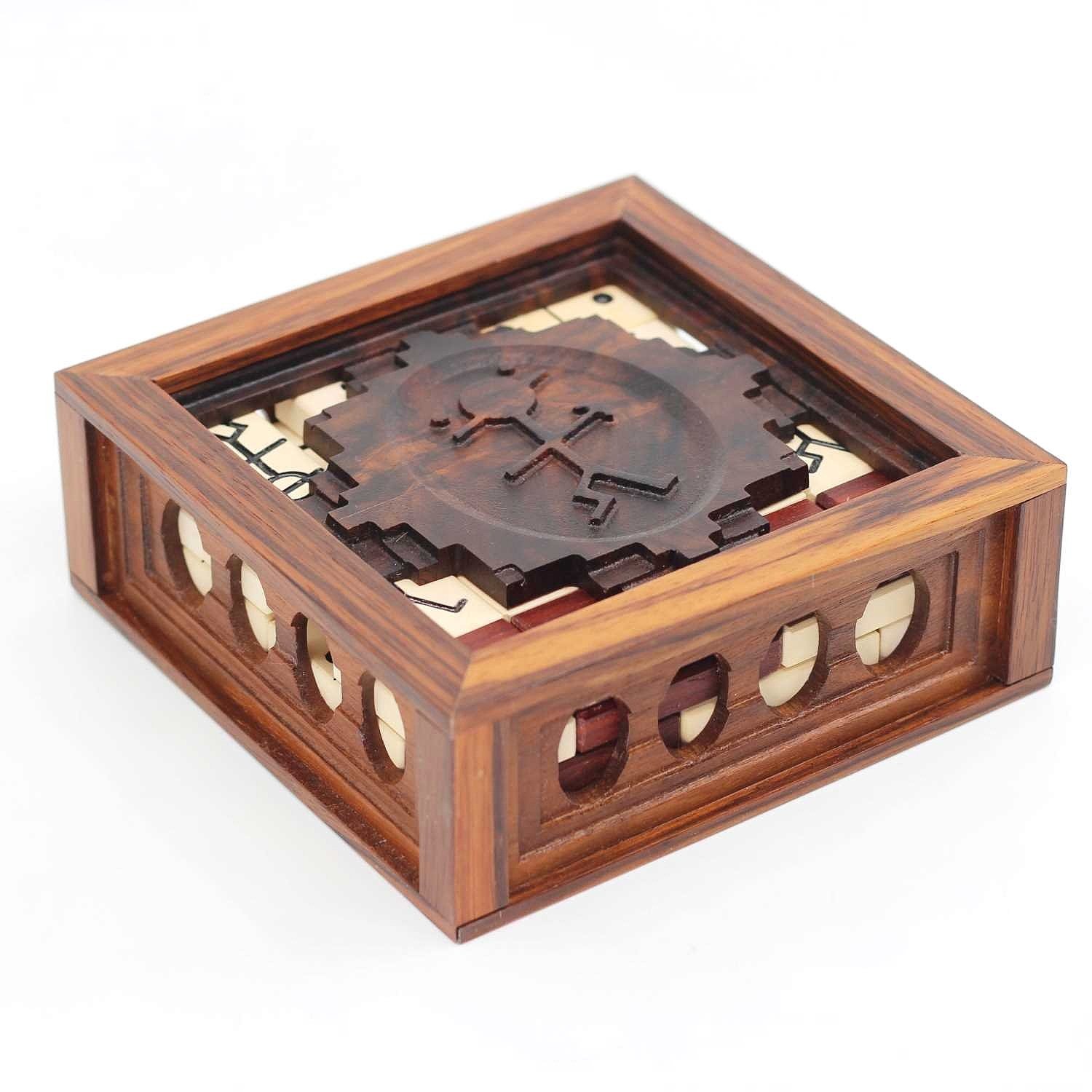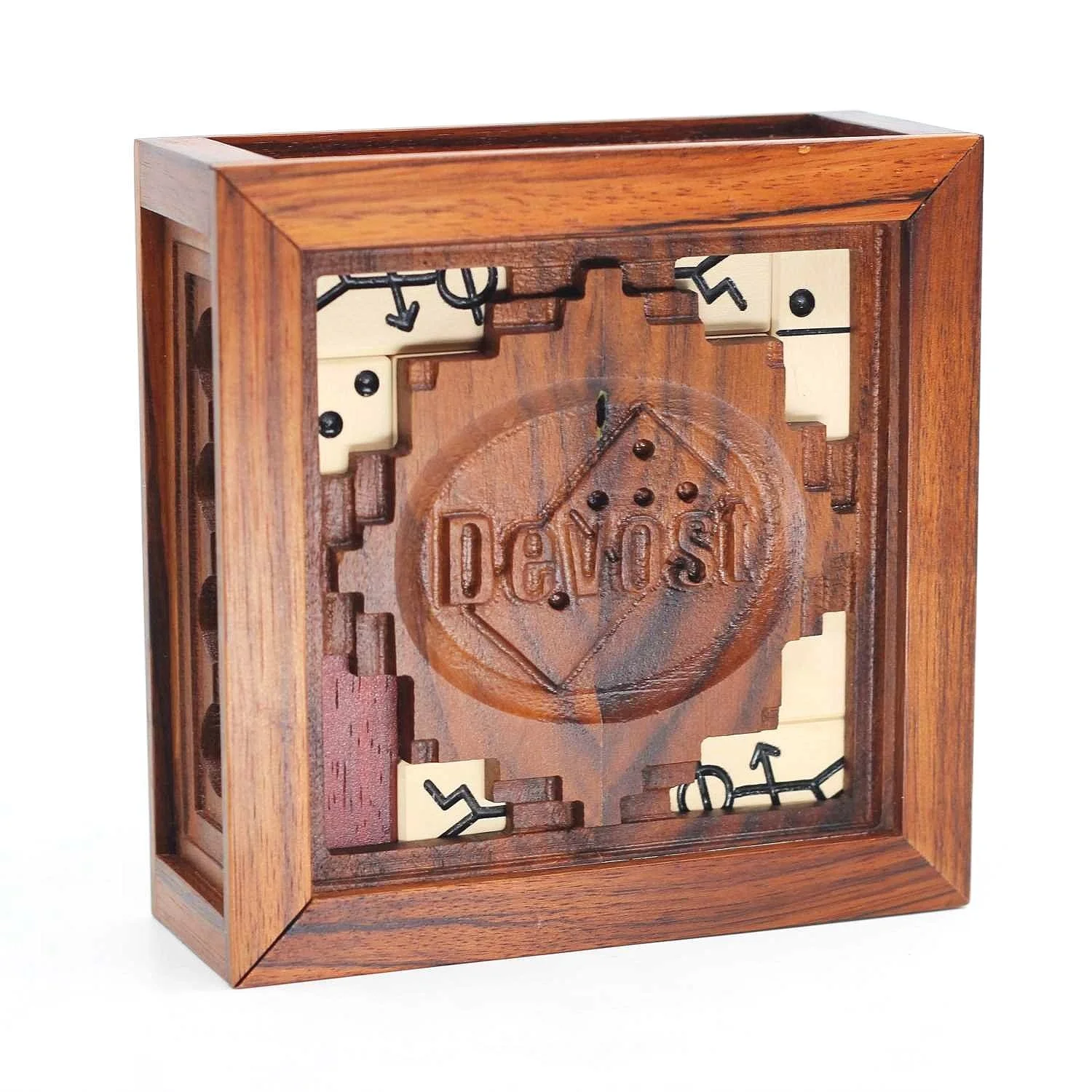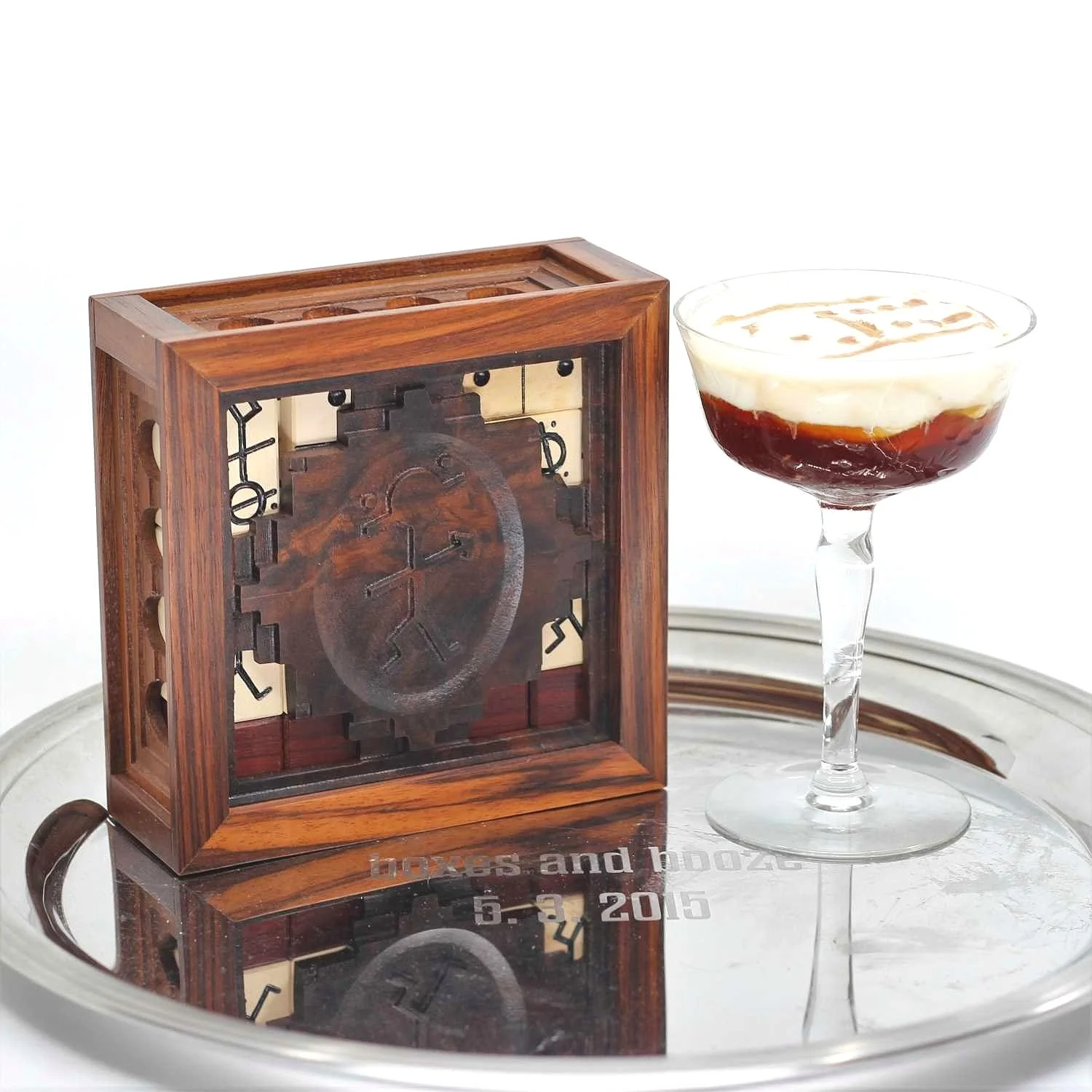Domino Box (Stickman 16)
Domino Effect
From the Latin dominus, “master of the house”, we have the English word for an ancient game of tiles that was invented in China sometime in the twelfth century. Domino tiles are rectangles twice as long as wide, which represent each possible combination roll of two six sided dice. Domino puzzle games can be traced back to late eighteenth century France, and reproductions can be found in Delft and Botermans classic “Creative Puzzles of the World”, 1978.
Domino Box by Robert Yarger and John Devost
Fast forward thirty more years and we find an altogether different Domino puzzle, one that represents much more than a puzzle box. On the surface, the Stickman Puzzlebox No. 16 by Robert Yarger is a beautifully crafted cage of Walnut and Monticello wood that houses a set of Holly dominoes crafted by John Devost. The external cage features carvings that pay homage to both Stickman and Devost (much to John’s chagrin). In addition to the complete set of tiles, there are a few oddly shaped pieces as well, made of Padauk wood. These pieces, and the tiles themselves, act as obstacles and barriers to opening the box, which can be quite challenging and requires careful planning. Moving the pieces around inside the cage is an act of dexterity and manipulation on top of strategic planning. Once open, the set is fully functional for game play, and can be reset in hundreds of ways for additional challenges.
Devostist with the mostist
But what makes this puzzle so much more has to do with the era and spirit of collaboration that was happening in the puzzle making community at that time, a period that Rob Yarger wistfully refers to as “Camelot”. Puzzle box making as more than just a hobby was fairly new, with the Karakuri group in Japan and other independent artists scattered around the world. Cubic Dissection, Eric Fuller’s fledgling site, was also new, and many artists would sell their wares through Eric’s venue. The internet was opening possibilities, and makers would meet and share trade secrets and customer lists on forums. The Stickman Domino box owes its existence to these forums.
Blocked Game
From Rob Yarger: “The concept started long ago at Renegade puzzle forum where (I think I recall it was) Kelly Snake was converting an old domino box into a puzzle. That sounds like an old Kelly project. The discussion came around of how awkward it was that, regardless of how dominoes were packed into a box, there was always at least one extra space, and this lack of symmetry seemed to bother most everyone. And yes, yes, an elongated box with 4 rows of 7 dominos accomplishes this, but that is hardly a packing puzzle, so the goal is to find some way to arrange them where length width and height were all a factor. So now, we have this entire forum of us nerds and geeks, each attempting to come up with some way to design a container, or slightly adjust domino sizes to get them all to fit in there somehow flush without a missing space. I think the burr tools program was used somewhere in there to prove beyond doubt that it was impossible, while others disagreed with the findings and produced geometry equations that showed it must be possible somehow.
Well, my approach has always been to use any flaw as an advantage when it comes to a puzzle, so why not take advantage of this missing space in some way. I wanted the [container] to be square though, in regards to a puzzle box, and that caused additional issues. I think that is where most of the above conflict came into play, as I was looking for ways to arrange them into a square shaped space. Again, it was all impossible, - but not if you crafted a few odd shaped pieces that went in with it all.
Partner in Crime by Will Lee
That sent the geek squad all off again, and burr tools was brought back into play, with no end of possible shapes for additional pieces being offered. I would like to take credit for the final shapes of the additional pieces, but in reality it was this lemming army of all us nerds running amuck to find some particular shapes that allowed for the most possible stacking variations, that would also allow for dominoes to be tilted to slide, but then allow the empty space to be manipulated up or down between tiers to lock it up even further. The configuration finally selected had the most potential for complexity, and the longest number of steps possible to revert to an unlock state.
Talk about a group project. I did not design this puzzle as much as it was a plethora of the most brilliant puzzle minds all focused on solving best how to accomplish this. I just made the freaking box once all of the dust final settled.”
“I tossed a weasel of an idea into a coop of brilliant chickens, and observed and produced a puzzle from the aftermath.” – Robert Yarger
John Devost was of course a major part of this artistic community and a sought after craftsman. Almost from the moment he heard that Rob was planning a Domino puzzle box, he knew he wanted to make the dominoes for it. He mentions that Rob had recently purchased the carving machine used for the box’s top and bottom panels that feature the two artists, and that gave him so much trouble he had to buy a second machine just to finish the puzzles. John is quite modest about his contribution, and mentioned that although he made and drilled the divets for the dominoes, Rob still had to hand paint and finish them all. Rob points out that John is simply a most generous spirit, who swooped in to offer his assistance at the right time. Rob likens him to a puzzle Mary Poppins: “Full of magic, and he is there because you have been found worthy, need him at some particular point of development in life. He imparts his gifts of wisdom, and then vanishes. The true puzzle hermit that you seek on the top of a mountain, but only appears for a spell of time to the pure of heart, then vanishes again.”
Scene of the crime
To celebrate the Domino box and all it represents I selected an appropriately named treat from Will Lee, one of Detroit, Michigan’s best known bartenders and the current beverage director at Grey Ghost. The cocktail was a collaborative effort between Lee and his bar manager at that time, who was “my right hand man … and one of my closest friends” – in other words, his partner in crime. From Lee: “The goal was to create a stirred, dessert style cocktail. Typically dessert cocktails lean towards the rich and decadent side, we were trying something a little bit different. The initial inspiration was a classic dessert, bananas foster. We wanted to take familiar flavors and deconstruct and present it in the format of a stirred, spirit forward dessert style cocktail.”
Like the best partners in crime, the spirits and flavors in this drink each play their part and hold up the rest for an incredible experience. A nicely smoky and bold scotch blend works well here to stand up to the sweet flavors, and the nutty amaro Averna adds decadent balance. Of course you might have a hard time resisting the whipped cream on top, but do try to enjoy at least one sip of the drink with some of it as well to get the whole experience. Cheers!
This pair is game
Partner in Crime by Will Lee
1 oz blended scotch
¾ oz banana liqueur
½ oz Averna
¼ oz amontillado sherry
2 dashes walnut bitters
2 dashes chocolate bitters
Garnish: cinnamon demerara whipped cream
Stir ingredients with ice and strain into a coup glass. Top with the whipped cream.
“All puzzles have a mind of their own. They want to create themselves. You can forbid this, and just do what you originally intended, and end up with a dry, tasteless puzzle. You can embrace this, let all of the factors in play have their say and influence. Let that dictate how it evolves, and you end up with a puzzle that (in this case) reflects the full flavor of a particular era in time, and a generation that was here for a moment, and now is gone forever, and the only way to relive it is by this artifact that was created from it. That is art.” – Robert Yarger
See more from this artist:






